Last Updated on January 18, 2024 by Greg Gillson
Do you want to feed birds in your yard this winter, but need some help getting started?
Are you looking for ideas on foods and feeders to attract many different kinds of birds?
Would you like to learn the common winter birds that are likely to come to your feeder?
You have come to the right place–this article is for you!
This article tells why and how to set up a bird feeder in Wisconsin in the winter. I’ll also show you photos of the common feeder birds in Wisconsin that you can look for at your own backyard feeder! I will give brief identification tips. I will tell you what foods and what type of feeders attract each species.
Winter in Wisconsin can be bitterly cold. Winter temperatures, December through February, rarely get above freezing during the day. Night time temperatures are much colder! Brrr…!
What about snow? Yes, Wisconsin has snow. Lot’s of snow. Snowfall averages about 40 inches in the south, and up to 160 inches in the north!
This weather means that those hardy birds that remain in Wisconsin in winter will really appreciate any food you put out at your feeder. Surprisingly–despite the cold and snowy weather, many birds live in Wisconsin year-round.
Why feed winter birds in Wisconsin?
The first reason to feed birds is that birds may need some help to make it through the long cold Wisconsin winters.
Now, birds wouldn’t remain if they couldn’t survive winter without us. And many kinds of birds do migrate south for winter. But many kinds also remain. They can survive without us. At least, many of them could.
However, more than half of the birds in early winter are young-of-the-year. They’ve never experienced winter before. If the winter is especially harsh, many of the younger birds may not survive, as opposed to the more experienced adults. Many young birds don’t survive winter. Your feeder may help a few young birds to survive winter that might not have made it otherwise.
And with more and more extreme weather, birds may be need our help while they adapt to rapidly changing climate.
A second reason to feed birds is to help us.
Yes, we may benefit from feeding birds–perhaps more than the birds themselves!
We, as a culture, are spending less and less time out-of-doors, especially children. Some social scientists are worried about the long-term mental and physical health risks to a society isolated from the natural world.
Watching the antics of birds at the feeder–even out the window from the comfort of our warm home, can provide many benefits. It just makes us feel good to observe such nature. It provides that connection to the natural world that we need–especially on those long, cold, dreary winter days.
Can you share nature–the birds at your feeders–with children or grand-children? What a wonderful way to bond! What a wonderful way to introduce children to nature. Many children do have a couple of weeks off from school in winter. A bird feeder could be a great joint project!

What birds come to feeders in winter in Wisconsin?
Of course, you can feed and enjoy birds without knowing their names.
But knowing what types of birds visit your feeder can spark your curiosity as to behavior and migration.
You may learn that certain birds only visit at certain times of year. Pretty soon, you will be in expectation of returning birds. And you may recognize something unusual.
I have written a companion article to common birds in the backyard in Wisconsin. This companion article discusses birds at all seasons, and includes backyard birds that might not visit feeders. I’ll link to this article again at the end, so you can read it next, if you want.
Following, then, are some of the common winter birds you can see at your feeder in Wiscnsin.
Black-capped Chickadee
This bird is a small active acrobatic ball off fluff.
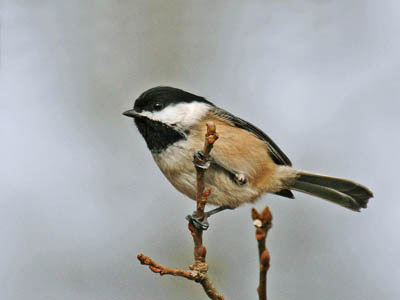 |
| Black-capped Chickadee. Greg Gillson. |
This bird is resident from Alaska and across Canada to the northern half of the United States.
Black-capped Chickadees are year-round residents in Wisconsin.
The white face is bordered by black crown and bib. Upper parts are gray, under parts buff.
Black-capped Chickadees love black oil sunflower seeds from hopper and tube feeders.
Dark-eyed Junco
These “snow birds” flock to your feeders in winter.
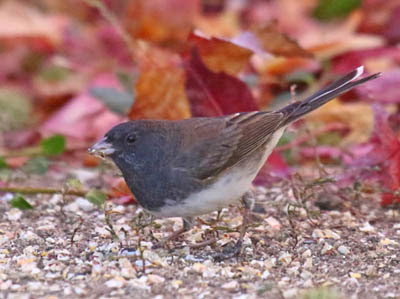 |
| Dark-eyed (Slate-colored) Junco. Greg Gillson. |
Breed in conifer and mixed woods across Canada and Alaska in summer, then migrate into most of the United States in winter. They are also resident in mountains of the West and Northeast.
Dark-eyed Juncos winter throughout Wisconsin and are year-round residents in northern Wisconsin.
The form in the East are small slate-gray birds with white belly and flashing white outer tail feathers. Females are browner. In the West, birds have black heads, brown backs, and pink sides.
Dark-eyed Juncos eat small seeds such as white proso millet on the ground or from low platform feeders.
Downy Woodpecker
This small woodpecker is widespread in North America and fairly common at bird feeders in winter.
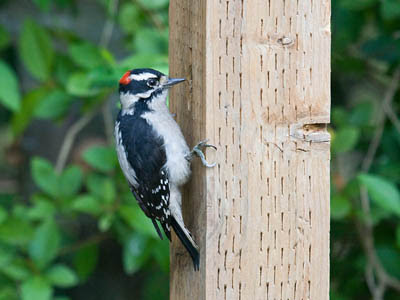 |
| Downy Woodpecker. Greg Gillson. |
Year-round residents from Alaska and across Canada south through the United States, but absent from the Desert Southwest.
Downy Woodpeckers are year-round residents throughout Wisconsin.
These are less than 7 inches long, bill tip to tail tip. They have a black and white striped head, white back, and black wings with white spots.
Downy Woodpeckers love suet from suet feeders. They also eat hulled sunflower seeds.
White-breasted Nuthatch
Nuthatches are active birds that crawl around branches and even head-first down tree trunks!
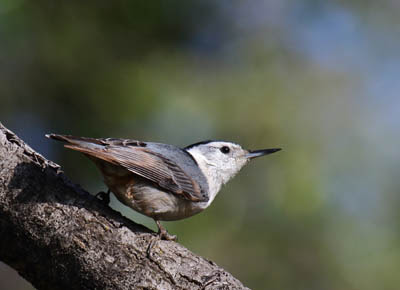 |
| White-breasted Nuthatch. Greg Gillson. |
These are widespread year-round birds across southern Canada and much of the United States. They avoid grasslands and deserts.
White-breasted Nuthatches are year-round residents throughout Wisconsin.
These are small chunk birds with large heads with long pointed bill and very short tails. These are gray above with black hind neck and crown. The face and under parts are white. They have a bit of rusty coloration on the flanks.
White-breasted Nuthatches eat black oil sunflower seeds from tube and hopper feeders and are fond of peanuts and suet, too.
Northern Cardinal
These are well-known birds due to their bright red coloration, fairly large size, and perky crest.
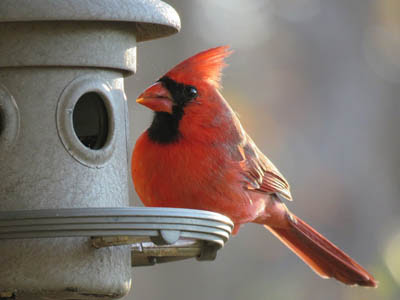 |
| Northern Cardinal. GeorgeB2 from Pixabay. |
These are year-round residents throughout the East and South.
Northern Cardinals are year-round residents throughout Wisconsin.
Larger than sparrows, but smaller than robins. Males are bright red, females brown. They have thick orange bills, black chin and throat, and obvious crests.
Northern Cardinals eat larger seeds, including sunflower seeds and safflower seeds from hopper and platform feeders, but often feed on the ground.
American Goldfinch
This bright yellow-and-black bird is a favorite summer bird. However, many people don’t recognize these birds at their feeders in their dull brown winter plumage.
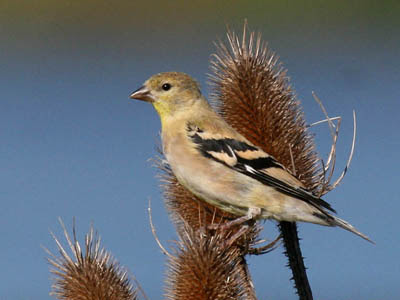 |
| American Goldfinch. Greg Gillson. |
Year-round residents across the northern half of the United States. In summer birds breed north well into Canada. In winter they move south throughout most of the U.S.
American Goldfinches are year-round residents throughout Wisconsin.
These are tiny birds with short forked black tails. Wings are black. Winter birds are dull brownish. In summer females are green while males are brilliant lemon yellow with black cap.
American Goldfinches eat black oil sunflower seeds from tube feeders. They love Niger seed from thistle feeders.
Mourning Dove
These birds are one of the most widespread in North America.
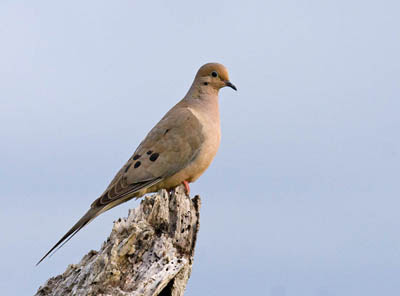 |
| Mourning Dove. Greg Gillson. |
In summer they breed in open fields, farms, prairies, towns, across all of the United States and north into Canada. In winter they depart most of Canada and the northern Great Plains and higher elevations in the northern states.
Mourning Doves are year-round residents throughout most of Wisconsin, but summer residents only in northern Wisconsin.
These plump birds have a small round head and pointed tail. They are larger than most feeder birds, but not as large as a domestic pigeon.
Mourning Doves eat mixed seeds and grains. They prefer eating on the ground or from platform feeders.
Blue Jay
These are well-known birds, displayed in advertising and sports teams.
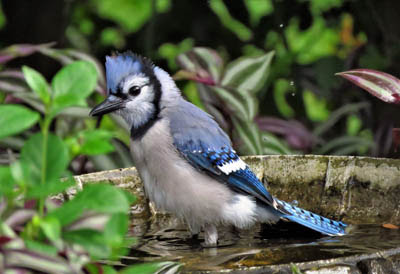 |
| Blue Jay. Skeeze from Pixabay. |
They live year-round in deciduous woods with oaks or nuts through most of the United States east of the Rocky Mountains. In summer they also migrate north well into Canada.
Blue Jays are year-round residents in Wisconsin.
These are blue above, white below and on the face, with a black necklace across the throat wrapping behind the head. The blue crest is a distinguishing mark.
Blue Jays eat sunflower seeds. They love peanuts, too. They use hopper and platform feeders.
Red-bellied Woodpecker
These woodpeckers are fairly common at bird feeders in the East, especially where there are larger hardwood trees.
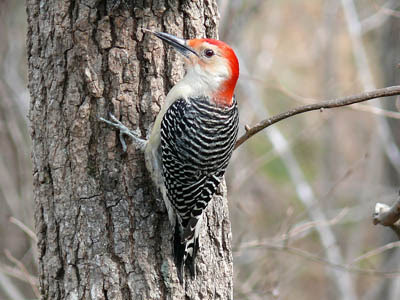 |
| Red-bellied Woodpecker. Skeeze from Pixabay. |
These birds live year-round in the United States east of the Rocky Mountains and Great Plains.
Red-bellied Woodpeckers live year-round in the southern two-thirds of Wisconsin, absent in northern Wisconsin.
These birds cling to tree trunks. They have finely barred black-and-white backs. The head and under parts are rather pale gray. Red feathers on the back of the neck reach the bill on males.
Red-bellied Woodpeckers love peanuts from platform feeders. They also eat sunflower seeds and suet.
House Sparrow
These are common city birds in noisy messy flocks.
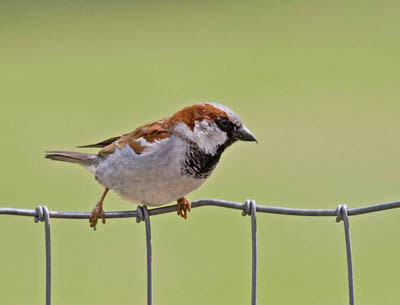 |
| House Sparrow. Greg Gillson. |
Found throughout much of Canada and the United States, wherever there are people and towns.
House Sparrows are year-round residents throughout Wisconsin.
Small squatty flat-headed sparrows. Females are rather brown and tan with a pale broad eyebrow, and plain breast without streaking. Males are more chestnut brown above with white wing bars, gray below, with gray crown and black chin, more extensive in summer.
House Sparrows eat a wide variety of small seeds and human food scraps from hopper and platform feeders, and also the ground.
Hairy Woodpecker
These are slightly bigger versions of the Downy Woodpeckers.
 |
| Hairy Woodpecker. Greg Gillson. |
Found from Alaska, across Canada, and south through most of the United States where there are big old trees.
Hairy Woodpeckers are year-round residents throughout Wisconsin.
Black wings and tail. White back and under parts. White stripes on face. Male with red spot on back of head. Bigger bill than Downy Woodpecker, otherwise look alike, but don’t use same kind of trees.
Hairy Woodpeckers will visit feeders in winter for suet and nuts.
House Finch
These are one of the most widespread feeder birds in the United States.
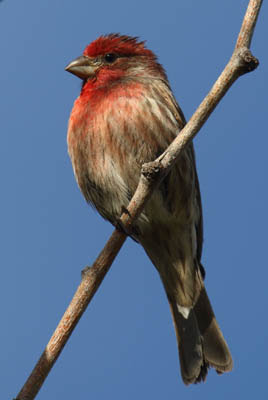 |
| House Finch. Greg Gillson. |
These birds are resident in towns throughout the United States, barely into southern Canada.
House Finches are year-round residents in southern and southeastern Wisconsin. Absent elsewhere.
Both males and females are rather dusty brown, heavily streaked on the chest. Only the males have red feathers on forehead, breast, and rump.
House Finches love to eat black oil sunflower seeds in the shell. They like tube feeders best.
Setting up a winter bird feeding station in Wisconsin
Many of the most common winter birds on this list would probably prefer a hopper feeder. These often are built with plastic sides and peaked roof. Food dispenses into a small tray at the bottom. These feeders protect the seeds and allow birds to easily reach the food.
Hopper feeders are good for mixed seed. My favorite is Wagner’s Songbird Supreme. (Click on the link to read my product review.)
The birds that will like mixed seed in the hopper feeder include White-breasted Nuthatches, Northern Cardinals, Mourning Doves, House Finches, House Sparrows, Blue Jays.
Of course, if you can also provide black oil sunflower seed alone in a tube feeder. Tube feeders keep away some of the larger jays and starlings that tend to eat up all the seed at once. These larger birds also tend to scare away the desirable smaller birds.
Birds that like black oil sunflower seeds in tube feeders include American Goldfinches, Black-capped Chickadees, House Finches, White-breasted Nuthatches.
In such cold weather, having a high-protein high-fat source of energy is important. So I recommend a suet and a suet feeder.
Birds that like suet include the woodpeckers. nuthatches, and chickadees. You may also attract other birds, like wrens and Yellow-rumped Warblers, that normally don’t come to feeders.
See my recommended bird feeder setup article below with specific brands and more details.
Finally, please think about setting up a bird bath with heater. Birds need fresh water to drink every day–especially in winter when natural water sources are frozen.
Wrapping Up
Winter in Wisconsin can be a challenging time for birds, but these feathered friends have evolved some fascinating adaptations and behaviors to survive the cold and scarcity of food. Here are some interesting facts about birds in winter in Wisconsin:
Staying Warm:
- Feathers: Birds have a layer of fluffy down feathers under their flight feathers, providing excellent insulation. Some species even grow an extra layer of down in winter.
- Counter-current heat exchange: This ingenious system minimizes heat loss in extremities like legs and feet. Blood flowing to cold extremities warms up against returning cold blood, preventing precious heat from escaping.
- Shivering: While less effective than in mammals, birds do shiver to generate heat, especially when perched still.
- Huddling: Small birds like chickadees huddle together at night to share body heat and conserve energy.
Finding Food:
- Dietary Shift: Many birds switch to high-fat diets in winter, as fats provide more energy per gram than carbohydrates or proteins. Seeds, nuts, and suet cakes are popular winter feasts.
- Caching: Some birds like jays and nutcrackers gather and hide food during fall, creating a hidden pantry to access during lean winter months.
- Adapting to new sources: While insects become scarce, some birds switch to berries, fruit, or even scavenge human scraps to survive.
Other Winter Adaptations:
- Duller Plumage: Some birds lose their vibrant summer colors, gaining duller or streaked plumage in winter. This can offer camouflage against predators in the snow and bare branches.
- Decreased Activity: Birds move less in winter to conserve energy, often only venturing out to find food and shelter.
- Migration: Many bird species, particularly warblers and thrushes, migrate south to escape the harsh winter conditions and find abundant food sources.
Frequently Asked Questions
What bird is in Wisconsin in the winter?
Determining which bird you’re likely to see in Wisconsin during the winter depends on several factors. Here are some common wintertime visitors you might encounter in your backyard:
- Common Redpolls: These small, finch-like birds with red caps migrate south from Canada and can be seen in open fields and woodlands, feeding on seeds and berries.
- Pine Siskins: These irruptive migrants with yellow streaks and wing bars appear in Wisconsin winters in response to abundant conifer seed crops.
- Evening Grosbeaks: These striking yellow and black birds with large beaks migrate south from Canada and can be seen at feeders, especially for sunflower seeds.
- Snow Buntings: These white birds with black wings and patches often flock to open fields and snow-covered areas, adding a touch of elegance to the winter landscape.
- Owls: Several owl species, like the Great Horned Owl and Eastern Screech-Owl, remain active throughout winter, hunting for small mammals and rodents.
Do birds use birdhouses in winter in Wisconsin?
Yes, birds definitely use birdhouses in winter in Wisconsin! In fact, these cozy shelters can be even more crucial for birds during the harsh winter months than they are in the spring and summer. Here’s why:
Benefits of birdhouses in winter:
- Warmth and Shelter: Birdhouses provide protection from the cold wind, snow, and rain, helping birds conserve precious body heat.
- Nesting opportunities: Some cavity-nesting bird species, like chickadees and bluebirds, may even seek out birdhouses for winter roosting, clustering together for extra warmth.
- Food source: If you provide birdseed or suet cakes near the birdhouse, it can become an additional source of food for hungry birds during times when natural food sources are scarce.
Types of birds that use birdhouses in winter:
- Resident birds: Black-capped Chickadees, Tufted Titmice, White-breasted Nuthatches, Downy Woodpeckers, and Blue Jays are some common Wisconsin residents that readily utilize birdhouses for roosting and shelter.
- Winter visitors: Common Redpolls, Pine Siskins, and Evening Grosbeaks may use birdhouses for roosting if suitable natural cavities are limited.
What is a black bird with a blue neck in Wisconsin?
The Common Grackle is considered short-distance migrant, moving south to escape frigid winters, but they can occasionally be found in Wisconsin during this season, albeit in much smaller numbers compared to spring and summer. Here are some potential places to try and spot them:
Locations:
- Urban areas: Look for them near buildings, parking lots, and garbage dumps, where they might find scraps of food and seek shelter from the elements.
- Farms and agricultural fields: Grains and leftover crop residues can attract them, especially during warmer spells when insects become available.
- Coniferous forests: Occasionally, small flocks might linger in sheltered conifer stands, particularly areas with berries or seed-bearing trees.
Related Articles:
The most common backyard birds in Wisconsin
Birds at your feeder in Wisconsin
Red, Orange & Yellow Birds in Wisconsin
My recommended bird feeder setup






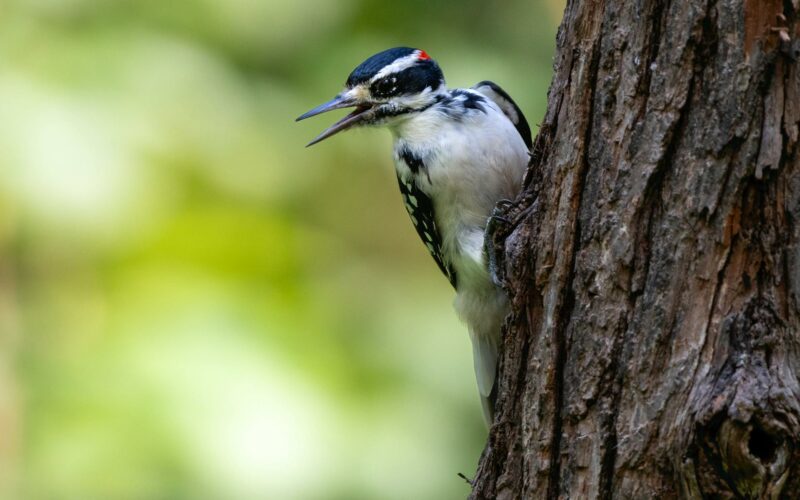
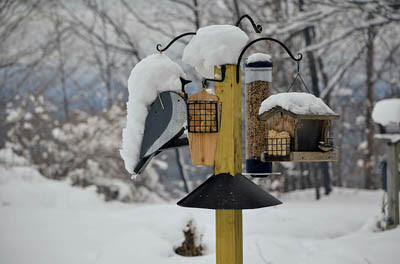
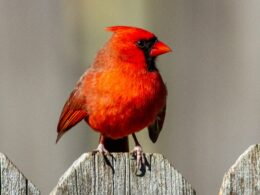
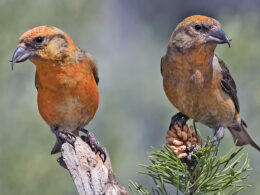
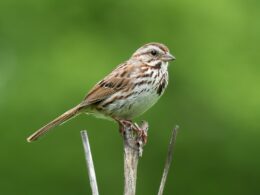
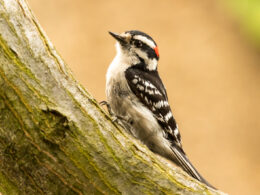
Great read and good information, Greg. I love seeing all these listed birds here in middle Wisconsin. I've seen Nuthatches tear apart my feedee to get that peanut drop! I'd also recommend adding Tufted Titmouse to your list, as I only see them around cold months.
Thanks, Thom!
The titmouse didn't make the list as it was only found in southern Michigan. But if you live there you can expect it as a year round resident in that more limited range.